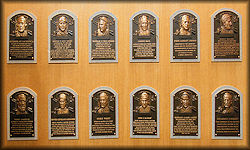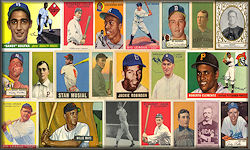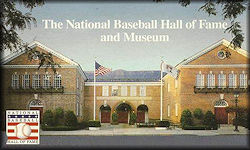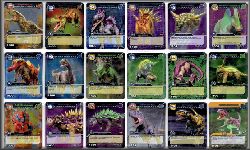George Wright was baseball’s first superstar player – an extraordinary shortstop who excelled for the game’s first openly all-professional team, the Cincinnati Red Stockings.
Born Jan. 28, 1847 in New York City, Wright belonged to one of the city’s preeminent sporting families. His father, Samuel, was a top professional at Harlem’s St. George Cricket Club who sought to make cricket as popular in America as it was in his native England.
In the 1850s, the St. George club moved across the Hudson River to the Elysian Fields in Hoboken, N.J., for more playing space. It was there that George and his older brother, Harry, would become infatuated with the new game of baseball. Though he was promoted to his father’s pro cricket team by age 16, George was equally interested in baseball and joined Harry on the New York Gothams amateur club in 1864.
Wright began his baseball career as a catcher before a foul tip to the throat caused him to move to shortstop. Still just a teenager, Wright’s natural athletic prowess quickly earned him a reputation as one of the best ballplayers in New York.
Wright moved to Philadelphia to become a cricket pro in 1865, but then quickly bounced from the Gothams to Long Island’s Morrisania and then to a Washington D.C. baseball club organized by the U.S. Treasury Department. Wright’s talents were in high demand, and he was praised by many as the best player in the country.
“There isn’t an infielder in the game today who had anything on George Wright when it came to playing shortstop, and certainly there was none during his time,” Hall of Famer Deacon White later said. “George fielded hard-hit balls bare-handed, gathered them up or speared them when in the air with either hand. He was an expert and accurate thrower, being able to throw with either hand.”
The Washington Nationals club embarked one of baseball’s first tours in July 1867, and followed their shortstop’s lead to phenomenal success. The Nationals beat Harry Wright’s Cincinnati team by a score of 53-10 and later attracted a crowd of 9,000 paying customers who watched the Nationals embarrass the Chicago Excelsiors 49-4. Over 29 games during the tour, George Wright collected an estimated 186 hits.
Wright was a pioneer at his position, becoming the first shortstop to play deep in front of the outfield grass to improve his range. He was named America’s best shortstop by the New York Clipper after the 1868 season.
In 1869, Wright helped make history by signing with Harry’s all-professional Cincinnati Red Stockings club. With a $1,400 salary, George was Cincinnati’s highest-paid player and unquestionably its greatest star. Batting out of the leadoff spot, Wright was otherworldly during his first season in the Queen City, belting 49 home runs and 304 hits (an average of nearly six per game), scoring 339 runs and sporting a .629 batting average while leading the Red Stockings to a perfect 57-0 record.
“George Wright never had any equal as a fielder, base runner and batsman,” said Hall of Famer Jim O’Rourke. “All his qualifications taken together, he was really in a class by himself, and I do not know of a ball player today who was ever entitled to be considered in the same breath with him.”
The Wright brothers led Cincinnati to another 27 consecutive wins the following season before other newly-formed professional clubs caught up with them. The Red Stockings’ attendance fell sharply after losing six games in 1870, causing the club’s board of directors to disband the team and return to amateurism. Undeterred, the brothers formed a club in Boston as part of the new National Association and created another dynasty.
With Harry guiding the team as manager, George flourished as one of the NA’s star players and led Boston to four consecutive pennants. After suffering a broken leg in 1871, Wright batted .388 in 1873, led the league with 15 triples in 1874 and bolstered his team to an incredible 71-8 record in 1875.
Though his skills declined in the late 1870s, Wright found glory once again when he captained the Providence Grays to a pennant over Harry’s Bostons in 1879. After his final professional baseball season in 1882, Wright remained one of America’s best cricket players through the turn of the century. He also gained additional fame as a sporting goods pioneer who brought tennis and hockey equipment to the American public for the first time. Wright is also credited with creating the first golf course in New England.
Though he passed away in 1937, Wright’s contributions to baseball are still easily recognizable in today’s game. In 1869, he advocated for a rule that enabled a baserunner to overrun first base in order to avoid collisions with the fielder. He also pioneered the shortstop’s strategy of sharing the middle base with the second baseman on double plays, depending upon which side of the infield a ball is hit.
In 1937, a committee formed by baseball Commissioner Kennesaw Mountain Landis selected Wright as one of a small group of baseball pioneers to be inducted into the Hall of Fame. (Ref: National Baseball Hall of Fame) |





